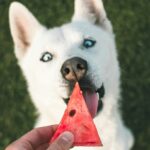Have you ever witnessed a dog confidently diving backwards into a pair of waiting arms, tail wagging, eyes gleaming with unwavering trust?
If you have, you may have found yourself pondering the curious phenomenon of dog trust falls.
But why do these four-legged companions, who epitomize loyalty and unconditional love, willingly participate in such an unusual activity?
This article will answer your questions.
Understanding the Phenomenon of Dog Trust Falls
Imagine this: you’re standing on the edge of a swimming pool, bracing yourself for the exhilarating sensation of free falling into the water.
But as you prepare to take the plunge, you notice your loyal furry friend, your dog, right beside you, seemingly unafraid.
In fact, your canine companion seems to trust the fall just as much as you do.
So, why is it that dogs seem to trust us so implicitly, even sometimes to the point of putting their lives in our hands?
Prey Instincts
One possible explanation for why dogs trust falls can be attributed to their instinctive nature as prey animals.
While domesticated dogs may not face the same dangers as their wild ancestors, their survival instincts have adapted to ensure their safety, giving them a remarkable sense of spatial awareness that allows them to gauge distances and calculate risks.
This natural instinct helps them accurately assess the fall and understand that it is within their physical capabilities to safely navigate it.
The Pack Mentality
Dogs are pack animals, and their instinctual behavior is deeply rooted in their ancestry as social animals.
Trust falls mimic the bonding and trust-building exercises seen in wild dog packs.
When dogs engage in this behavior, they are essentially communicating and reinforcing their trust and dependency on their human pack member.
By falling backward and trusting their human to catch them, dogs are strengthening the bond and hierarchy within their social group.
The Pursuit of Safety and Security
Dogs are masters at reading our body language and are quick to assess their environment for any potential threats.
Trust falls provide dogs with a sense of security and reassurance, especially in unfamiliar or potentially stressful situations.
When a dog leans backward and is caught by their human, they perceive it as a form of protection.
It reinforces their belief that their human will provide safety and keep them out of harm’s way.
This innate need for security drives dogs to trust fall as a way to seek comfort and solace in their relationship with their human.
Bonds of Domestication
Furthermore, the bond between a dog and its owner is built on trust and mutual reliance.
Dogs look to us, their humans, for guidance, protection, and comfort.
When they see us confidently taking a plunge or jumping into the unknown, they interpret it as a signal that it’s something they can also do without harm.
Dogs are highly observant creatures, and they often mimic our behaviors.
Therefore, when they witness our trust in the fall, they mirror that trust and confidently follow suit.
This bond is the result of a long history of domestication.
Dogs have been living alongside humans for thousands of years, evolving alongside us as our faithful companions.
This close proximity and constant interaction with humans have ingrained in them a sense of trust and dependency.
They rely on us for food, shelter, and protection, and in return, they give us their undying loyalty.
Building Trust and Overcoming Fear
One of the main reasons why dogs trust fall is because it helps them overcome their natural instincts and fears.
Dogs are naturally cautious creatures, always on the lookout for potential threats.
By practicing trust falls, dogs learn to let go of their anxiety and trust their human’s ability to catch them.
This helps them feel safe and protected in their human’s arms, strengthening the bond between them.
Trust falls also promote a sense of vulnerability and dependence in dogs.
This vulnerability allows them to rely on their humans for protection and support.
It helps dogs understand that their humans are there for them in times of need, creating a deep sense of trust and companionship.
By engaging in trust falls, dogs learn to rely on their humans and form a solid foundation of trust, which is vital for a strong and lasting human-dog bond.
The Power of Imitating Trust
Trust falls are not only an instinctual behavior but can also be a learned behavior for dogs.
As social animals, dogs have a remarkable ability to imitate and learn from their pack members.
If a dog sees another dog or even its human trust falling, they are more likely to imitate this behavior.
Dogs learn by observation and often mirror the actions of those they trust.
Therefore, if a dog witnesses their human consistently catching and providing safety during trust falls, they are likely to adopt the behavior themselves.
It’s a case of learning through imitation and further strengthens the bond between humans and their furry companions.
Moreover, the social nature of dogs plays a crucial role in their trusting nature.
Dogs, by nature, are social animals that thrive in pack-like environments.
As they form strong bonds with their human families, they perceive us as part of their pack.
This sense of belonging and togetherness fosters a deep level of trust between dogs and humans.
It’s one of the reasons why dogs are often willing to put themselves in vulnerable situations, knowing that we’ll be there to protect and support them.
Practical Ways to Encourage Trust Falls and Foster Trust in Your Dog
Building trust with your furry friend is not just important for a harmonious life together, it’s also essential for their overall well-being.
Dogs are naturally trusting creatures, but sometimes they need a little extra encouragement to fully embrace trust falls.
So, how can you help your pup develop a stronger sense of trust?
Here are some practical tips to encourage trust falling and other trust-building exercises:
1. Create a safe environment: Building trust starts with creating a safe space for your dog.
Make sure they have a cozy bed, a designated spot in the house, and a comfortable crate if needed.
Keep their environment consistent and familiar to help them feel secure.
Remember, a dog who feels safe is more likely to engage in trust-building activities.
2. Gradual socialization: Exposing your dog to new people and situations in a gradual manner is key.
Arrange controlled meetups with friends and family, ensuring that each encounter is positive and stress-free.
Encourage others to offer treats and gentle petting to build positive associations.
This incremental socialization will help your pooch feel at ease with different individuals and build trust over time.
3. Strengthen the bond through positive reinforcement: Positive reinforcement is a powerful tool in fostering trust.
Use praise, treats, and rewards to reinforce good behavior and build a strong bond with your dog.
Remember to be patient and consistent, as trust-building takes time.
With each successful trust fall, celebrate the accomplishment and provide reassurance to show your furry friend that they made the right choice.
Ensuring Safety and Avoiding Potential Risks during Trust Falls with Your Dog
In order to ensure safety and avoid potential risks during trust falls with your dog, it is important to take certain precautions and follow proper guidelines.
Trust falls can be a fun and bonding activity for you and your furry friend, but keeping safety in mind should always be a top priority.
1. Begin with a strong foundation: Before attempting trust falls, it is crucial to establish a strong foundation of trust and obedience with your dog.
Training them in basic commands such as ‘sit’ and ‘stay’ will make the process smoother.
Trust falls should only be attempted with dogs who are comfortable with physical contact and have a good understanding of your commands.
2. Create a safe environment: Choose an open and quiet space for trust falls to minimize distractions and potential hazards.
Remove any objects that could cause injury or obstruction.
Ensure the area is clear of sharp edges, slippery surfaces, or any other dangers that might harm your dog during the activity.
3. Gradually increase difficulty: Start with simple trust falls from a low height, gradually building up to more challenging ones.
Allow your dog to get used to the feeling of being caught and gradually gain confidence.
Always be attentive to their comfort level and never force them to participate if they seem scared or uncomfortable.
FAQ
Q: So, what exactly is a trust fall for dogs?
A: You know those moments when you see a dog startle or jump into your arms as if their life depends on it?
Well, that’s the famous trust fall maneuver for dogs!
They willingly, and sometimes quite dramatically, throw themselves against you, seeking solace and security.
Q: Wait, I thought trust falls were a human thing?
A: Humans may have popularized the trust fall as a team-building exercise, but our canine companions have a similar instinctual behavior.
Dogs, being social creatures, often rely on their trust in others to feel safe and secure.
Q: Why do dogs engage in trust falls?
Is it only about feeling secure?
A: That’s part of it, but there’s more to it than just seeking safety.
Trust falls in dogs are not only a way to physically feel secure, but also to build an emotional bond with their trusted human.
It’s like pressing a reset button for them, soothing their anxieties, and making them feel loved and cared for.
Q: Are trust falls only seen in certain breeds or age groups?
A: Trust falls are not exclusive to specific breeds or age groups.
Dogs of all sizes, from tiny Chihuahuas to majestic Great Danes, can exhibit this behavior.
Similarly, both puppies and older dogs might engage in trust falls.
It seems to be more related to an individual dog’s personality and their history of positive experiences with their human.
Q: Is it possible for a dog to learn to trust fall?
A: Absolutely!
Dogs can definitely learn to trust fall with consistent positive reinforcement and love from their humans.
By creating a safe and nurturing environment, we can foster a strong bond with our four-legged pals, leading to trust falls becoming a cherished ritual between us.
Q: How can we encourage trust falls in dogs?
A: Patience and understanding are key when encouraging trust falls.
It’s crucial to create a peaceful atmosphere and make your dog feel secure in your presence.
Offering gentle pets and cuddles, using soothing tones of voice, and rewarding them with treats and praise are simple but effective ways to build trust.
Q: Are there any risks associated with trust falls for dogs?
A: While trust falls are generally harmless, it’s important to remember that dogs have varying levels of trust and comfort.
Some dogs may not be as inclined to trust fall due to past traumas or anxiety.
Always be mindful of your dog’s body language and never force them into any behavior that makes them uncomfortable.
Q: Any final thoughts on this adorable dogs trust fall phenomenon?
A: Trust falls in dogs are a testament to the beautiful bond we share with our furry friends.
It’s a reminder that they look up to us not just for protection but also for emotional support.
o, next time your pup dramatically throws themselves against you, embrace it with open arms and revel in the unconditional love they offer.
Trust falls are just one way our furry companions communicate their trust and affection for us!
Essential Insights to Remember
As we discussed, the trust fall behavior in dogs stems from their instincts and the lessons learned in their early days.
Puppies learn to rely on their mother and littermates, relying on the safety net of their furry family members to catch them whenever they stumble or fall.
Building upon these foundations, dogs extend their trust to their trusted humans.
Furthermore, we discovered that trust falls are not only a display of trust but also a form of communication.
Dogs use this behavior to indicate their vulnerability and their belief that we will always be there to catch them.
It’s their way of saying, “I trust you wholeheartedly.”
But let’s face it – watching our canine friends perform trust falls is simply heart-melting.
It puts a smile on our faces and reminds us of the immense trust our furry friends place in us.
It’s a powerful testament to the unconditional love and loyalty they offer, reminding us of why dogs truly are our best friends.
So, next time your four-legged companion leans back into your arms with those adoring eyes, embrace the trust fall with open arms – both literally and metaphorically.
Cherish that moment and reciprocate their trust, reaffirming the unbreakable bond you share.














